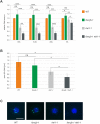An Arabidopsis FANCJ helicase homologue is required for DNA crosslink repair and rDNA repeat stability
- PMID: 31120885
- PMCID: PMC6550410
- DOI: 10.1371/journal.pgen.1008174
An Arabidopsis FANCJ helicase homologue is required for DNA crosslink repair and rDNA repeat stability
Abstract
Proteins of the Fanconi Anemia (FA) complementation group are required for crosslink (CL) repair in humans and their loss leads to severe pathological phenotypes. Here we characterize a homolog of the Fe-S cluster helicase FANCJ in the model plant Arabidopsis, AtFANCJB, and show that it is involved in interstrand CL repair. It acts at a presumably early step in concert with the nuclease FAN1 but independently of the nuclease AtMUS81, and is epistatic to both error-prone and error-free post-replicative repair in Arabidopsis. The simultaneous knock out of FANCJB and the Fe-S cluster helicase RTEL1 leads to induced cell death in root meristems, indicating an important role of the enzymes in replicative DNA repair. Surprisingly, we found that AtFANCJB is involved in safeguarding rDNA stability in plants. In the absence of AtRTEL1 and AtFANCJB, we detected a synergetic reduction to about one third of the original number of 45S rDNA copies. It is tempting to speculate that the detected rDNA instability might be due to deficiencies in G-quadruplex structure resolution and might thus contribute to pathological phenotypes of certain human genetic diseases.
Conflict of interest statement
The authors have declared that no competing interests exist.
Figures







Similar articles
-
The RecQ-like helicase HRQ1 is involved in DNA crosslink repair in Arabidopsis in a common pathway with the Fanconi anemia-associated nuclease FAN1 and the postreplicative repair ATPase RAD5A.New Phytol. 2018 Jun;218(4):1478-1490. doi: 10.1111/nph.15109. Epub 2018 Mar 25. New Phytol. 2018. PMID: 29577315
-
Specialization among iron-sulfur cluster helicases to resolve G-quadruplex DNA structures that threaten genomic stability.J Biol Chem. 2013 Sep 27;288(39):28217-29. doi: 10.1074/jbc.M113.496463. Epub 2013 Aug 9. J Biol Chem. 2013. PMID: 23935105 Free PMC article.
-
A minimal threshold of FANCJ helicase activity is required for its response to replication stress or double-strand break repair.Nucleic Acids Res. 2018 Jul 6;46(12):6238-6256. doi: 10.1093/nar/gky403. Nucleic Acids Res. 2018. PMID: 29788478 Free PMC article.
-
FANCJ helicase operates in the Fanconi Anemia DNA repair pathway and the response to replicational stress.Curr Mol Med. 2009 May;9(4):470-82. doi: 10.2174/156652409788167159. Curr Mol Med. 2009. PMID: 19519404 Free PMC article. Review.
-
Mutational analysis of FANCJ helicase.Methods. 2016 Oct 1;108:118-29. doi: 10.1016/j.ymeth.2016.04.023. Epub 2016 Apr 21. Methods. 2016. PMID: 27107905 Review.
Cited by
-
DNA- and DNA-Protein-Crosslink Repair in Plants.Int J Mol Sci. 2019 Sep 3;20(17):4304. doi: 10.3390/ijms20174304. Int J Mol Sci. 2019. PMID: 31484324 Free PMC article. Review.
-
Meiotic DNA Repair in the Nucleolus Employs a Nonhomologous End-Joining Mechanism.Plant Cell. 2019 Sep;31(9):2259-2275. doi: 10.1105/tpc.19.00367. Epub 2019 Jul 2. Plant Cell. 2019. PMID: 31266898 Free PMC article.
-
Regulator of telomere elongation helicase 1 gene and its association with malignancy.Cancer Rep (Hoboken). 2023 Jan;6(1):e1735. doi: 10.1002/cnr2.1735. Epub 2022 Oct 17. Cancer Rep (Hoboken). 2023. PMID: 36253342 Free PMC article. Review.
-
Changes in genotoxic stress response, ribogenesis and PAP (3'-phosphoadenosine 5'-phosphate) levels are associated with loss of desiccation tolerance in overprimed Medicago truncatula seeds.Plant Cell Environ. 2022 May;45(5):1457-1473. doi: 10.1111/pce.14295. Epub 2022 Mar 8. Plant Cell Environ. 2022. PMID: 35188276 Free PMC article.
-
G4 Structures in Control of Replication and Transcription of rRNA Genes.Front Plant Sci. 2020 Oct 8;11:593692. doi: 10.3389/fpls.2020.593692. eCollection 2020. Front Plant Sci. 2020. PMID: 33133121 Free PMC article.
References
-
- Cantor SB, Bell DW, Ganesan S, Kass EM, Drapkin R, Grossman S, et al. BACH1, a novel helicase-like protein, interacts directly with BRCA1 and contributes to its DNA repair function. Cell. 2001; 105: 149–160. - PubMed
Publication types
MeSH terms
Substances
LinkOut - more resources
Full Text Sources
Molecular Biology Databases
Research Materials
Miscellaneous

